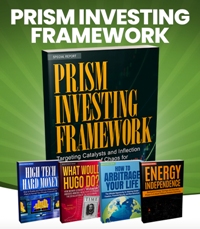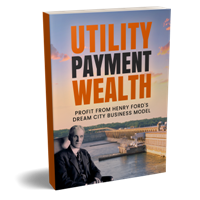 “Give me liberty or give me death!”
“Give me liberty or give me death!”
– Patrick Henry
Shutdown Season
The clock is ticking. Congress has until the end of the month to avert a partial government shutdown. Federal agencies, and their dependent employees, are counting on a last-minute deal to keep the money flowing to their coffers.
Certainly, there have been government shutdowns in the past. In fact, since 1976 there have been 20 of them. Typically, they just last for a day or two. But the most recent partial government shutdown, which took place during President Trump’s 1st term – between December 22, 2018, and January 25, 2019 – lasted for 35 days.
Government shutdowns, without question, can be highly disruptive. This is especially true in America in the year 2025 where a good part of the population is dependent on Washington in some form or another. Federal employees, contractors, businesses and individuals who rely on government services will quickly feel the pinch as federal dollars disappear.
When it comes down to it, a government shutdown is a failure to pass a budget. Congress, having power of the purse is supposed to pass appropriations bills to fund federal agencies and programs. When the fiscal year ends on September 30th, if these bills haven’t been passed and signed into law by the President, government funding runs out.
When this happens, federal agencies must stop all non-essential activities. This is a partial government shutdown, where all government services that aren’t considered critical to public safety and national security are stopped.
This all comes back to politics. Republicans hold a 219-212 majority in the House of Representatives and a 53-47 edge in the Senate. The chamber’s rules require 60 votes to pass most bills. Thus, support from seven Democrats will be needed to pass a funding bill.
By Golly
Senators and Representatives are politicking. They want to shape the narrative so when there’s a shutdown the other party can be blamed.
This week, for example, Senate Minority Leader Chuck Schumer wrote a letter to colleagues stating that, “The only way to avoid a shutdown is to work in a bipartisan way, with a bill that can get both Republican and Democratic votes in the Senate.”
Schumer, of course, doesn’t want to avoid a shutdown. He wants to use the prospect of a shutdown to help the Democrats politically.
One of the primary issues, as far as we can tell, is healthcare coverage. The One Big Beautiful Bill Act, signed into law on July 4, 2025, included cuts to Medicaid and Medicare. These cuts were needed to fund President Trump’s tax cuts.
The Congressional Budget Office estimates these reductions could result in millions of Americans losing their health insurance coverage over the next decade. Democrats are looking to use the funding deadline to get their way. Senator Elizabeth Warren recently explained the strategery:
“In September the Republicans are going to need to get a budget through to keep the government open and to do that they are going to need some Democratic votes. You want my vote – and I hope the votes of the rest of these Democrats – then by golly, you can restore healthcare for 10 million Americans!”
The forthcoming budget impasse is a high-stakes gamble. Many lowly federal workers will be sacrificial pawns in the game. Whether a federal employee is furloughed or not comes down to whether they are essential or non-essential.
Ripple Effects
Essential employees are those whose jobs are deemed necessary to protect life and property. Military personnel, federal law enforcement officers, air traffic controllers, certain medical professionals, and the like. They continue to work, often without pay, until a funding bill is passed.
Non-essential employees are workers who are furloughed or placed on mandatory unpaid leave. These are employees of useless administrative agencies like the Bureau of Land Management, the National Park Service, and countless others. They are not allowed to work. Federal contractors may also have their contracts suspended.
Still, a government shutdown is more than just political fisticuffs by Washington bogtrotters. There are real, tangible effects on the lives of millions of Americans. When hundreds of thousands of federal employees are unable to spend their paychecks, it creates a ripple effect on local economies.
Small businesses that rely on federal workers to consume their products or services struggle. Cafés next to federal buildings find their customers have disappeared from one day to the next. Delays in processing federal development permits can stall business expansion and investment. Data center projects on federal land, which are needed to support the burgeoning AI revolution, are put on ice.
So too, the shutdown of non-essential services can affect a wide range of public programs. This means delays in processing applications for Social Security benefits or veterans’ claims. National parks and museums may close, impacting tourism and local businesses.
A shutdown also has political ramifications. The party perceived as being responsible for the shutdown may suffer during the next election. And when the shutdown ends, there’s a ramp up period while things return to normal.
How a Government Shutdown Can Restore American Independence
A government shutdown can also impact financial markets. While the political drama unfolds in Washington, traders, investors, and analysts closely watch for signs of market instability.
Typically, stock market investors consider a government shutdown to be short term noise. Unlike a debt-ceiling standoff, which threatens the government’s ability to pay its bills, a shutdown does not directly impact the Treasury’s ability to service its debt. This is why the stock market doesn’t usually panic.
The S&P 500 has generally been flat during past shutdowns. The average return of the S&P 500 during the 20 government shutdowns that have occurred since 1976 is 0.04 percent. Moreover, during the 35-day government shutdown in 2018-19, where approximately 800,000 federal workers were furloughed or required to work without pay, the S&P 500 rose 10.3 percent.
That doesn’t mean there won’t be a panic this time around. Stocks, at this very moment, are riskier than they’ve ever been. They’re even more risky than they were on March 10, 2000, at the peak of the dot com mania. If you recall, over the following 30-months the NASDAQ crashed 78 percent. The S&P 500 also lost nearly 50 percent over this time.
The stock market, right now, is a bubble searching for a pin. The prospect of a government shutdown may deliver just the prick that’s needed to let out all the frenzied gas that has built up over the last decade. A bear market is long overdue. Now is as good a time as any to get on with it.
Likewise, here at the Economic Prism we believe a government shutdown’s precisely what’s needed for the health and wellness of all Americans. Quite frankly, there’s no reason such a massive cross section of the economy should have ever been made dependent on the government to start with.
In truth, the U.S. government is beyond broke. Without money printing and inflation, it cannot meet the obligations it has committed to. A shutdown – a lengthy one – may just be what is needed to shrink the size of government and restore some independence back to the American people.
But let’s not kid ourselves. Americans, circa 2025, prefer comfort and safety to liberty and independence.
In standard fashion, the political hacks in Congress will come to an agreement at the 11th hour. Some sort of continuing resolution to keep the lights on will be reached…
…and America will continue down the ugly road towards the complete overturning of society. We anticipate the crisis moment will be triggered sometime before the next presidential election.
[Editor’s note: Have you ever heard of Henry Ford’s dream city of the South? Chances are you haven’t. That’s why I’ve recently published an important special report called, “Utility Payment Wealth – Profit from Henry Ford’s Dream City Business Model.” If discovering how this little-known aspect of American history can make you rich is of interest to you, then I encourage you to pick up a copy. It will cost you less than a penny.]
Sincerely,
MN Gordon
for Economic Prism
Return from How a Government Shutdown Can Restore American Independence to Economic Prism





http://www.jesus-is-savior.com/
http://www.jesus-is-savior.com/how_to_be_saved.html
It is very simple to be saved and takes only a minute to explain. Please let me show you how to get to Heaven from the Bible, God’s Word…
Man is a Sinner in the Eyes of a Holy God.
Isaiah 53:6, “All we like sheep have gone astray; we have turned every one to his own way; and the LORD hath laid on him the iniquity of us all.”
Romans 3:19, “Now we know that what things soever the law saith, it saith to them who are under the law: that every mouth may be stopped, and all the world may become guilty before God.”
John 3:3, “Jesus answered and said unto him, Verily, verily, I say unto thee, Except a man be born again, he cannot see the kingdom of God.”
Romans 3:10, “As it is written, There is none righteous, no, not one.”
Romans 3:23, “For all have sinned, and come short of the glory of God.”
There is a Price For Our Sin–Burning in Hell Forever.
Romans 6:23, “For the wages of sin is death; but the gift of God is eternal life through Jesus Christ our Lord.”
Romans 5:12, “Wherefore, as by one man sin entered into the world, and death by sin; and so death passed upon all men, for that all have sinned.”
2nd Thessalonians 1:8, “In flaming fire taking vengeance on them that know not God, and that obey not the gospel of our Lord Jesus Christ.”
Revelation 20:15, “And whosoever was not found written in the book of life was cast into the lake of fire.”
Revelation 21:8, “But the fearful, and unbelieving, and the abominable, and murderers, and whoremongers, and sorcerers, and idolaters, and all liars, shall have their part in the lake which burneth with fire and brimstone: which is the second death.”
Jesus paid that price by dying on the cross and shedding His blood; Christ was buried and bodily rose again the third day!
Romans 5:8, “But God commendeth his love toward us, in that, while we were yet sinners, Christ died for us.”
John 3:16, “For God so loved the world, that he gave his only begotten Son, that whosoever believeth in him should not perish, but have everlasting life.”
1st Timothy 1:15, “This is a faithful saying, and worthy of all acceptation, that Christ Jesus came into the world to save sinners; of whom I am chief.”
1st Peter 1:18-19, “Forasmuch as ye know that ye were not redeemed with corruptible things, as silver and gold, from your vain conversation received by tradition from your fathers; But with the precious blood of Christ…”
1st Corinthians 15:1-4, “Moreover, brethren, I declare unto you the gospel which I preached unto you, which also ye have received, and wherein ye stand; By which also ye are saved, if ye keep in memory what I preached unto you, unless ye have believed in vain. For I delivered unto you first of all that which I also received, how that Christ died for our sins according to the scriptures; And that he was buried, and that he rose again the third day according to the scriptures.” This is the Gospel.
By faith in Jesus Christ ALONE we are immediately saved.
Galatians 3:26, “For ye are all the children of God by faith in Christ Jesus.”
John 11:25, “Jesus said unto her, I am the resurrection, and the life: he that believeth in me, though he were dead, yet shall he live.”
John 6:28-29, “Then said they unto him, What shall we do, that we might work the works of God? Jesus answered and said unto them, This is the work of God, that ye believe on him whom he hath sent.”
Ephesians 2:8-9, “For by grace are ye saved through faith; and that not of yourselves: it is the gift of God: Not of works, lest any man should boast.”
John 14:6, “Jesus saith unto him, I am the way, the truth, and the life: no man cometh unto the Father, but by me.”
John 6:40, “And this is the will of him that sent me, that every one which seeth the Son, and believeth on him, may have everlasting life: and I will raise him up at the last day.”
Mark 1:15, “And saying, The time is fulfilled, and the kingdom of God is at hand: repent ye, and believe the gospel.”
Acts 26:18, “To open their eyes, and to turn them from darkness to light, and from the power of Satan unto God, that they may receive forgiveness of sins, and inheritance among them which are sanctified by faith that is in me.”
Romans 10:13, “For whosoever shall call upon the name of the Lord shall be saved.”
1st Corinthians 3:11, “For other foundation can no man lay than that is laid, which is Jesus Christ.”
Galatians 3:26, “For ye are all the children of God by faith in Christ Jesus.”
Salvation is NOT found in a religion or good works, but in a Person… The LORD JESUS CHRIST!
Simply BELIEVE the Gospel and You Are Saved!
History is full of stories of the death of empires. The number one disease has been debt. This time the only difference will be the number of casualties.
LORD IS YAHWEH/Jehovah and he is not god!
Your ignorance puts Jehovah/Satan before Jesus,
before GOD! Shame on you!
God save us from Old_Testament_ of _Lies!
Religion the perfect slave maker!
Jehovah is Satan!!!